Osprey, Yellowstone National Park

This osprey was very cooperative by not moving for a long time.
This site is dedicated to wildlife and landscape photography.

This osprey was very cooperative by not moving for a long time.

It’s hard to write a blog while visiting Yellowstone in the spring because there is light until 9:00 p.m. and it takes an hour to get back to Gardiner where I’m staying. Then there is dinner and downloading images. I’m writing this while my car gets an oil change.
When people visit Yellowstone they’re looking for mammals, especially bears and wolves and they large herbivores they prey on. But the park has a lot of interesting smaller animals, including birds. I found this osprey in the Gardner River Canyon. I’ve checked on four active nests in and around the park. No eggs have hatched yet. I haven’t seen any nests near the Gardner River.
Birthing among the mammals is well underway. I’ve seen a few baby pronghorn. Yesterday was the third day in a row that I’ve seen and photographed an elk calf in its first day of life. I stopped at the Mammoth Visitor Center yesterday and there was an elk calf being born right next to the building on the lawn. It stood up 45 minutes after being born. I’m looking forward to seeing my first bighorn lambs of the year.
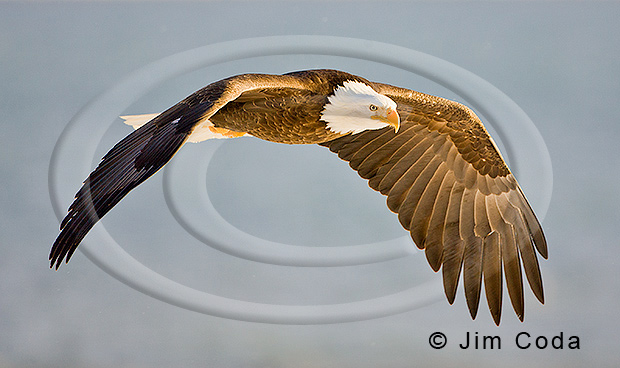
Each year on or about this day I post a photo of a bald eagle to recognize and celebrate the fact that five years ago today the Fish & Wildlife Service announced that the bald eagle in the lower 48 States had recovered enough to be removed from the list of threatened and endangered species. We almost lost it due to DDT and other persistent pesticides. Thanks to Rachel Carson, the Endangered Species Act and other factors, the story of the bald eagle in the lower 48 was a story of success. The same can be said for other species like the osprey, which was also hurt by DDT. Unfortunately, it doesn’t always work out that way.

I think that most everyone who has an interest in wildlife knows that when a bald eagle sees an osprey flying with a fish the bald eagle will chase and harass the osprey and get it to drop the fish (which the eagle then dives for and catches). The osprey gives up at this point so it can live and fish another day.
What people may not be as aware of is that bald eagles do this to each other too and if one loses the fish it doesn’t give up. The aerial dog fights can go on for a long time and they can be quite spectacular. Changes of possession can become numerous because when one dives on the other the one with the fish usually opens its talons to defend itself and loses the fish in the process. This results in a dive by both eagles to be the first to catch the falling fish. It gets even ore interesting when the fight takes place where numerous eagles gather. They all get involved.
I’ve seen some interesting things happen in these dogfights. I’ve seen one or both crash into the water. Sometimes they can get airborne from the water, but sometimes they can’t and they then try to get to land. If they don’t make it to land before hypothermia, they die.
This is one of the more unusual photos I’ve taken of bald eagles fighting. One eagle has his talons into the upper tail of the other and is flying along carrying the other, but they are losing altitude. Sorry, I don’t remember how it ended.
I learned about Jim Goldstein’s blog project some time in 2011. To learn more about it click here. Basically, you do a blog about your best 10 or so photos of the year and Jim will link your blog to his list of blogs that participate. I recently looked at some of the 2010 participants’ “Best 10” blogs. It’s a great way to find good nature photographers you weren’t aware of.
I photographed a lot at Point Reyes National Seashore in 2011 so I decided to use Point Reyes wildlife photos that were in my blog in 2011. I want to say at the outset that I never really photographed much at Point Reyes before 2011 and I was very surprised at how good wildlife photo opportunities are there. I’m a big fan of Yellowstone, but Point Reyes is almost the equal of it and in some ways it’s better. For example, I’ve never seen a single bobcat in Yellowstone and hardly ever fail to see one at Point Reyes.
So, without further ado, here are some of my favorite Point Reyes wildlife photos that were in my blog in 2011.
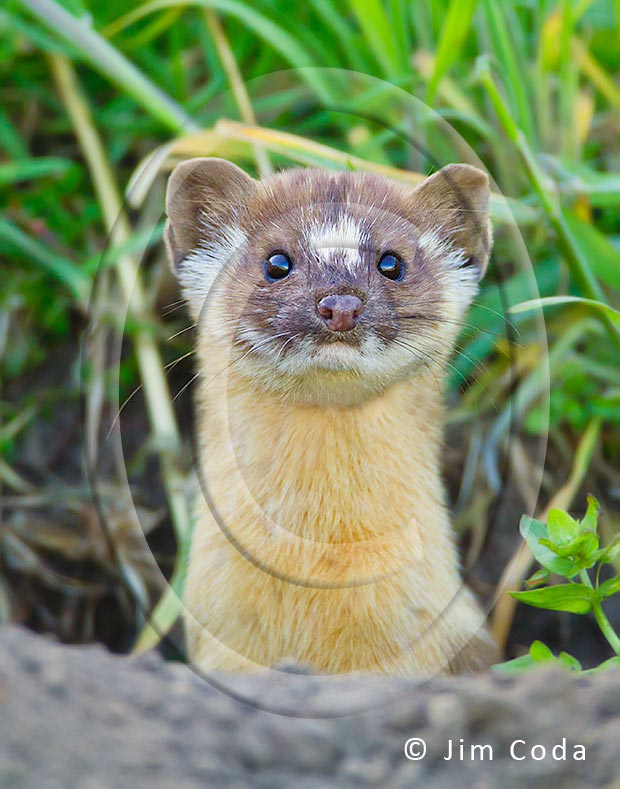
Long-tailed weasels are one of my favorite animal subjects at Point Reyes. Unfortunately, they are hard to find. I saw four last year in Point Reyes, but this guy is the only one I was fortunate enough to get close photos of.

Bobcats are a lot easier to find, especially in the winter. This male lived on one of the ranches along Pierce Point Road. I saw him a lot last winter, but he disappeared in the early spring. I’m not sure what happened to him, but I think a pack of coyotes got him. I saw them pass through the open area he used to hang out on. I think he could have held his own with one coyote, but I doubt he could do so with two or more. There were no trees or other means of escape anywhere near where I used to see him. I photographed him a lot and miss him.

Point Reyes has a healthy population of coyotes. Like the bobcats, they are easiest to find in the winter when they spend more time out during daylight.
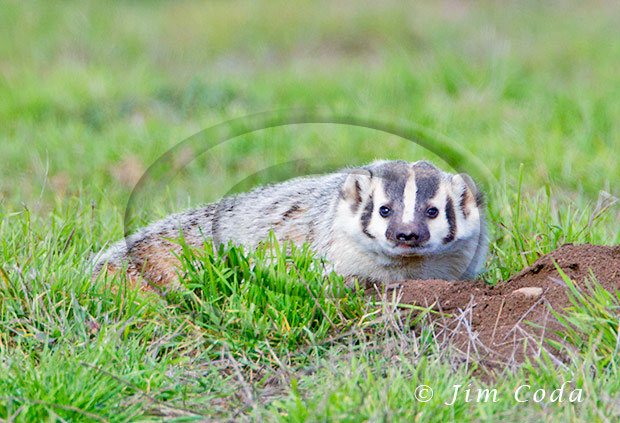
Point Reyes has a good population of badgers, but they are somewhat hard to find because they are such nocturnal critters. In 2011 I photographed two single adults plus two females in the spring with two cubs each. This is one of the single adults. I found this individual a couple of weeks ago.

Of all the wildlife Point Reyes has I think the species people think of first is the tule elk. They are fairly easy to find and photograph at Point Reyes. Needless to say, this photo was taken during the rut. With his angry-looking eyes and wide-open mouth he looks pretty fierce. Every time I see how big his mouth is I picture four canine teeth in there and wonder what life would be like if elk had canines.

Point Reyes has some resident peregrine falcons. They are often seen from Chimney Rock to the Point Reyes Lighthouse. This one decided to dine in ranch country.
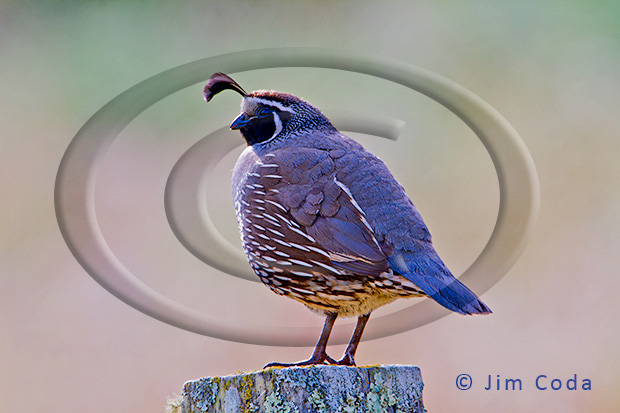
California quail are quite common in the Seashore. When things are slow they can save the day. I think the peregrine above was feeding on a quail.
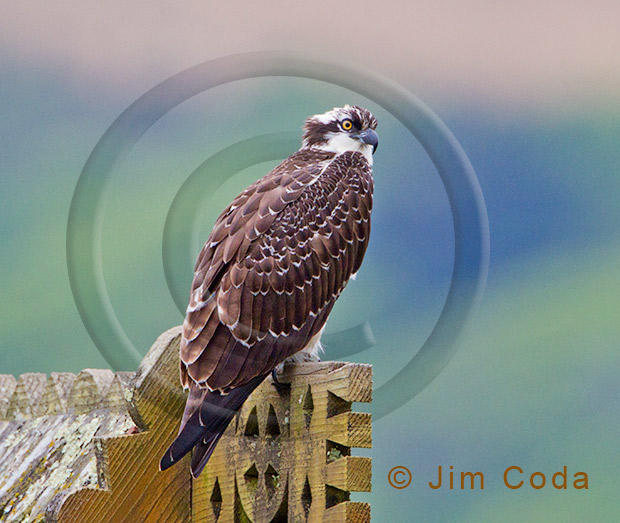
There are several ospreys that live and nest in and around the Seashore. This one decided to perch on a dock in Inverness which is just over the ridge from the Seashore.
Red-tailed Hawk, Point Reyes National Seashore
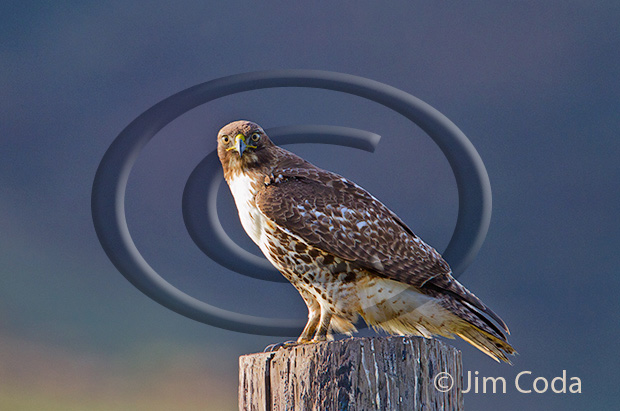
Red-tailed hawks are common at Point Reyes, especially in the winter. They are probably the raptor seen most often in the Seashore.
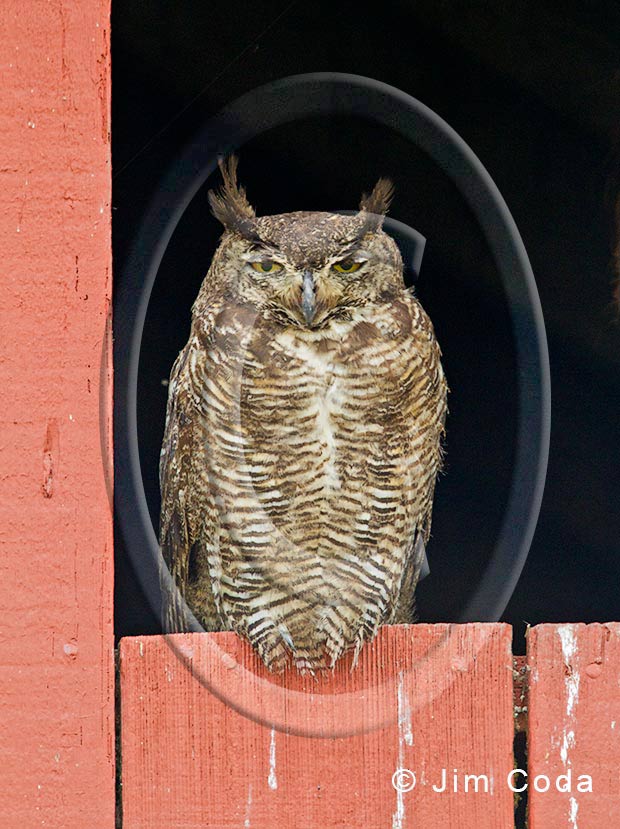
Great horned owls are also common, although you don’t see them as often as their numbers would suggest because of their nocturnal ways. Find any good sized clump of trees, though, and odds are good that you will find one or more great horned owls in there. Pound for pound they are about the most deadly bird in North America. While they normally prey on mammals and birds smaller than them, they have been know to prey on such things as house cats, canada geese and even bald eagles. Field Guide to Owls of California and the West, Hans Peeters, at 191.
There are a lot of other wildlife species at Point Reyes , many of which I blogged about, but it’s time to stop. If you’d like to see some more images from Point Reyes or elsewhere you can continue viewing my blog or you can visit my website, www.jimcoda.com.
Happy New Year to All, and thank you Jim Goldstein.

I was backing up some images recently and realized I had forgotten that I photographed this osprey last month. I like the background in this photo which is comprised of the hills on the east side of Tomales Bay. The bird is perched on the top of an ornate gate to a dock along the shoreline in the town of Inverness on the way into Point Reyes National Seashore.
Have you ever seen something in nature that struck you as odd? In May of 2009 I saw something that I thought was very odd. I was driving into Yellowstone’s Lamar Valley from the west and off to my right not far from the Lamar River I saw a large nest atop a dead tree. My first thought was that it was probably an osprey nest or maybe a bald eagle nest. I slowed down and pulled over. I could see there was something in the nest, but it was too far to see what it was exactly. I decided to grab my big lens and tripod and hike closer to the nest. After a bit I stopped. I couldn’t believe my eyes. It looked like a Canada goose. I looked through my lens. It was a Canada goose.

This was a new one for me. Canada geese nest on the ground, usually in wetlands. What was this one doing up in a raptor’s nest? Maybe it had learned the hard way that eggs laid on the ground in the Lamar Valley don’t last long. I checked every day for over a week and there was always a goose in the nest. There had to be eggs there. Will the eggs fare better in a raptor’s nest at the top of a tall tree? Maybe. Maybe not. Furthermore, to the best of my knowledge, Canada geese don’t feed their young like birds of prey do. The goslings will have to get down to the ground and to the river soon after they hatch. I know some waterfowl species like wood ducks nest in tree cavities and the young drop down to the ground, but this is a very tall tree and the branches extend well away from the trunk, especially in the lower portion of the tree outside the framing of the image. Finally, how will they walk across all those branches with their webbed feet?

When I returned to Yellowstone in May of this year I looked to the nest as I entered Lamar Valley. There was a bird in it again. This time it was an osprey.
I’ve often wondered what happened to the offspring of the Canada geese. Did the eggs survive to hatching? If so, did the goslings make it safely down the tree and to the river? I guess I’ll never know.
